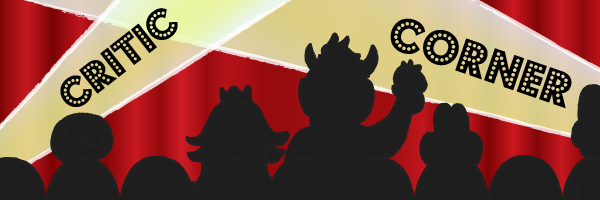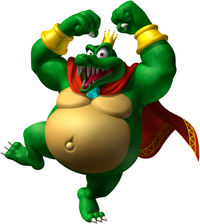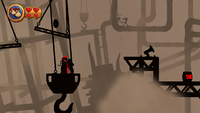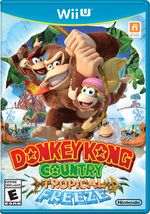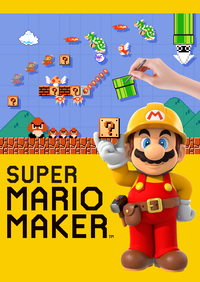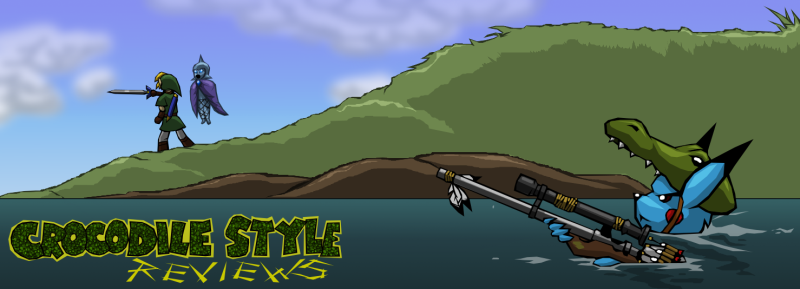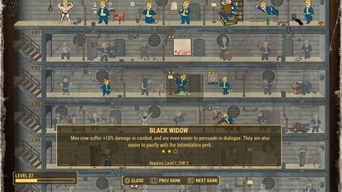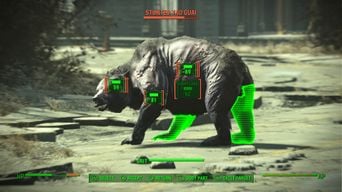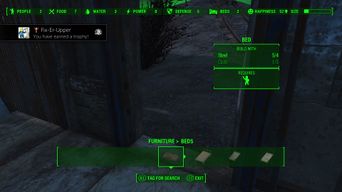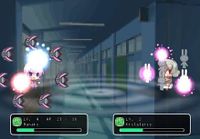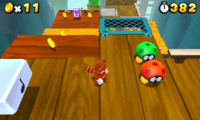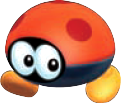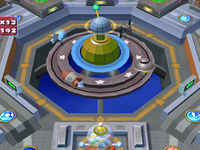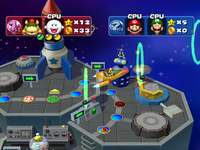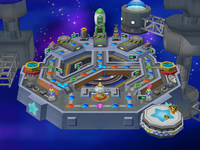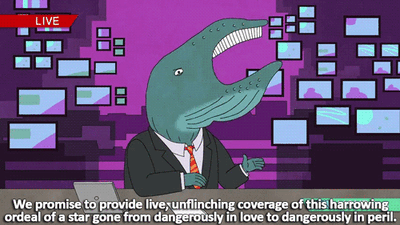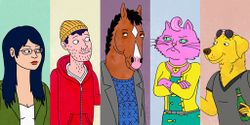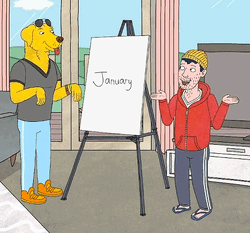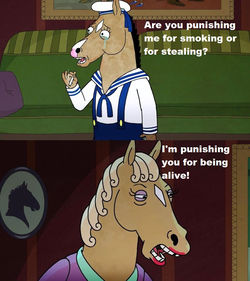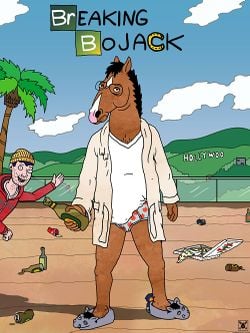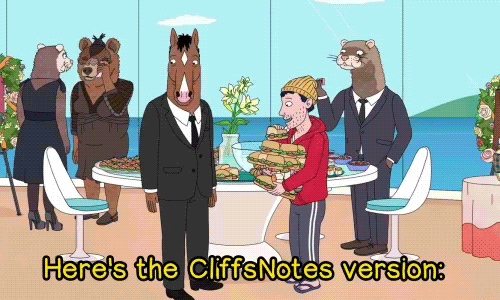The 'Shroom:Issue 106/Critic Corner
Director's Notes
Written by: Crocodile Dippy (talk)
Bloody hell, is it 2016 already? We've already pissed away half of the decade on this newsletter, and we're still kickin' hard and strong? That's actually impressive, if not a little sad as well. But hey, don't let me bring you down, it's a brand new year, ripe for us to all start making big proclamations that we're going to turn our lives around, make big changes, which we all inevitably never follow through on. My only resolution is to not waste the entire year getting drunk, but y'know, #AussieGirlProblems. Seriously, tho, I hope you had a lovely Christmas and New Years, and will continue to have a wonderful year for the rest of 2016. And for all you Aussies out there, happy early Australia Day in just a few days; go to a BBQ party, have a beer, and remember not to be a racist dickhead in the name of "patriotism". That's all I ask, really.
Anyway, on to the issue at hand, which is quite a doozy this time around. Look at all these sections we have this month! It's incredible! I haven't seen this many since Issue 100 way back in July, which was a bloody special issue, no less! Among the sections is a brand new writer for our beloved sub-team by the name of DragonFreak (talk), who will be writing an RPG review section titled DragonFreak's Review Quest each month. I hope we can keep this momentum up, it'd certainly be fantastic to have this much content available to you, our beloved readers, every month. Maybe you, our beloved readers, can help, by signing up for one of the many vacant positions listed on our sign-up page, or even a position that isn't listed there, if you have an idea you think would be really good for Critic Corner. Just some food for thought. In sadder news, Marshal Dan Troop (talk) has resigned from Shoey's Shoetacular Reviews, unfortunately. I wish him all the best in all his future endeavours.
Also, please be sure to check out the Lightning Opinion Piece Contest Entrants below the table of contents! The participants have worked very, very hard on these entries concerning various aspects of the Donkey Kong universe, and I'd hate for them to be overlooked... especially since their victories hang in the balance of your votes! Please be sure to read them all thoroughly and cast your vote on which entrant you think best fits the criteria outlined in last month's contest outline. Again, be thorough with your observations! It's important that we give credit to the most well-written of the entrants, not just because they covered a subject you like. So yea, thanks for that!
Section of the Month
| Critic Corner SECTION OF THE MONTH | ||||
|---|---|---|---|---|
| Place | Section | Votes | % | Writer |
| 1st | Character Reviews | 7 | 31.82% | Yoshi876 (talk) |
| 1st | Location, Location | 7 | 31.82% | Time Turner (talk) |
| 3rd | Marioverse Reviews | 3 | 13.64% | PowerKamek (talk) |
| 3rd | Crocodile Style Reviews | 3 | 13.64% | Crocodile Dippy (talk) |
It's this time again, the time where we honour all the miserable berks who have contributed to last month's issue that were held up on a pedestal of glory by the readerbase at large! By which I mean, we're here to discuss the Section of the Month winners for the December issue, so let's get right into it, shall we? Hmmm... well, seems we've had ourselves a sequence of ties this month, with the first place winners being both Yoshi876 (talk) for his Character Review of the woefully shallow Sprixie Princesses from Super Mario 3D World, Nintendo's misguided effort to create a new damsel-in-distress without putting any effort into making them interesting; and Time Turner (talk) for his Location, Location review of Fahr Outpost, which he does not recommend as a tourist destination if you're looking for some snowboarding or snowman-building for your holiday fix.
The runner-ups were also a tie, between PowerKamek (talk) for his Marioverse Review of the ever-charming and adorable Yoshi's Wooly World; and yours truly, for my Crocodile Style Review of the cynical and dreary Assassin's Creed: Syndicate. So yea, that's that for the winners of the December Section of the Month! Make sure to vote this month, since your votes count, and help feed the egos of all my writers so they don't think it's all hopeless and just give up, go home, and gorge themselves on buckets of ice cream to quench the loneliness and pointlessness they have learned dominates this chaotic, uncaring world. Thanks!
PowerKamek builds his section from scratch in this review of Super Mario Maker.
[read more]
Dippy braves the wastelands for this explosive review of Fallout 4.
[read more]
DragonFreak makes her review debut, but first, have some orange juice!
[read more]
Lightning Opinion Piece Contest
Entrant One
While Nintendo has always been a master of gameplay, they are often criticized in being a little lacking in the story department. However, 1994 brought with it Donkey Kong Country, a game which used innovative pre-rendered graphics to tell a tale of the triumph of capitalism over communism. Released just after the fall of the Soviet Union, developer Rareware delved deep into the DK lore to tell this tale of Kong-unism. Donkey Kong himself has always been portrayed as the spitting image of a typical American: strong, handsome, and hardworking, with a love of good food (bananas). Donkey Kong Country cemented this picture by giving DK a tie for the first time, making it clear that he had a proper white collar job, the foundation of capitalism. DK is shown to be very successful, having built up a proud banana hoard. Unfortunately, one night, the no-good communist King K. Rool - whose name depicts the cruel nature of Red rule - steals DK's hard-earned bananas, and redistributes the wealth across the land. Of course, our brave hero regains his hoard, and K. Rool literally takes a fall – just like the USSR – as he loses his crown.
If Donkey Kong Country is a tale about the struggle between capitalism and communism, then the 2014 entry Donkey Kong Country: Tropical Freeze can be seen as a tale about a more current issue: immigration. Developer Retro Studios ramps us the story with a scathing game that makes us question if our own hero is actually a racist. When a group of Snowmads come upon Donkey Kong Island while looking for a new home, DK takes offense to the cold they bring, which blows out the candle on DK's birthday banana. While this should be a small price to pay, DK goes bananas, killing the inhabitants of many islands in an journey to retake his home. Throughout the game, DK comes across as appalling and it is completely impossible to sympathize with him. It’s a scathing portrayal of someone that we've come to love, and like all great works, causes us to challenge what we know. It makes us question our view of America, and maybe, in a broader sense, the whole world.
Upon reflection, this paranoia is a theme that can also be seen in the reboot Donkey Kong Country Returns. While originally published in 2010, it was re-released on the Nintendo eShop in 2015, and looking back on this game after Edward Snowden’s NSA leaks, the game takes on a whole new meaning. DKCR (again published by Retro Studios) shows the fear of a country plagued by surveillance. Donkey Kong awakes one morning to find a Tiki – a representation of government – in his house, watching everything he does. The Tiki attempts to hypnotise DK, but he is able to resist submitting blindly to the government's spying. Tragically, however, he finds that the rest of his island has given in to the Tikis (and, in a reference to the communist plot of the original game, the animals have once again stolen his bananas). Each boss battle also finds DK fighting the Tikis while being watched by a crowd of spectators, subtly showing how you can never really escape government surveillance. Notably, late in the game, DK visits a government factory, likely devices that probably include cell phones, computers, and cameras. Though the factory is initially filled with smoke, DK turns on fans to blow away the fog, metaphorically rescuing the island from the clouded vision the government presents them.
The Donkey Kong Country series is a beautiful one for being the only Nintendo series to tackle complex situations in such a mature way. While it may not always be pleasant, it’s important to think about the issues it brings to light. I hope after reading this analysis, you can start to look at these games in a new way.
Entrant Two
When Donkey Kong Country was released, it was made clear that the Donkey Kong from the arcade original had grown old, started going by the name Cranky Kong, and had been succeeded by a younger descendant. But just who this modern Donkey Kong was has been something that has confused fans for a long while. Is he Cranky’s son or grandson? Throughout the years, there has been evidence supporting both sides of this issue, but I will offer my own take on this situation and say that both Cranky’s son and grandson have been featured in the series.
During Donkey Kong 64, Cranky Kong refers to Donkey Kong as his son. This leads me to believe that the Donkey Kong introduced in the Rare era was indeed Cranky’s son, and, by extension, Donkey Kong Jr. After saving his father from Mario, he grew up and battled against the Kremlings from Donkey Kong Country through to Donkey Kong 64. After finally defeating the Kremlings for the last time (for now, anyway), Donkey Kong eventually decided to leave Donkey Kong Island to pursue a new way of life. During his youth, he had been to the Mushroom Kingdom and tried his hand at kart racing, and decided to return there, participating in many local events, such as karting, golf, tennis and parties, as well as clashing with Mario a few times.
But who is the one who has appeared in the newer Donkey Kong Country games, referred to as Cranky’s grandson? This is none other than the third Donkey Kong, whose first appearance was alongside his father in Mario Tennis 64 as the character Donkey Kong Jr. Since the adult Donkey Kong in the game is the same as the original Donkey Kong Jr., then it stands to reason that this DK Jr. has to be a different one. It is this Donkey Kong that returns to the island and currently protects it from new threats such as the Tikis and the Snowmads.
I am aware that there are still flaws in this theory, such as the original Donkey Kong Country games having references to DK as Cranky’s grandson (although a source at Rare once stated that this was incorrect and that DK64 has it right) and the fact that it still leaves most Donkey Kong games outside of the Country series unaddressed, but I believe that it is still a plausible option for a potential Donkey Kong family tree. Of course, we’ll likely never get a proper explanation for all of this, given Nintendo’s general indifference to storytelling and continuity in Mario-related games, but that just means there is more room for us to come to our own conclusions about these kinds of things.
Entrant Three
Of the three SNES games I had growing up, Star Fox was the one I could never beat, Super Mario World was the one I'd beat repeatedly, and Donkey Kong Country was the one I only needed to beat once, since the replay value of the individual levels was more than enough to keep me entertained for years. And it's not just me: when my non-gamer friends visit, this is the only platformer they want to play alongside Mario Kart and Super Smash Bros. Not even the simultaneous play of New Super Mario Bros. Wii can compare, since they just end up in bubbles half the time anyway, whereas they last a lot longer and have more fun along the way thanks to DKC's simple, power-up-less gameplay and the forgiving nature of having two Kongs to buffer them from instadeath over every mistake. But those are far from the only things that give DKC a special pick-up-and-play value that SMW, Super Mario Bros. Deluxe and other beloved classics in my collection can't quite match.
It can take a dozen reruns before I've had my fill of Mine Cart Carnage in a sitting, and while no other level is quite as addictive (in this or any other game), the vast majority of DKC courses are still tonnes of fun. There are a few levels I dislike, but for the most part, it's only because they are completely terrifying, from the horrible rock monsters of Stop & Go Station, to Tanked Up Trouble, in which the lights on the achingly slow platform go out one by one with ear-biting tinks, counting down to when you run out of fuel and plummet to your death. But the fact that these levels are among the most vividly etched into my memory is in itself a testament to the game's ability to really set a tone when it wants to - which is another things that separates it from the other platformers I grew up with. It always blew me away when night fell at the end of the first level, followed by a thunderstorm that gave way to a beautiful sunrise: so much better than the token night level thrown in now and then in otherwise static platformers. But my hands-down favourite weather is the ominously approaching snowstorm in Snow Barrel Blast; once it hits, the level's hell, but that just makes the dread you feel as real as the relief that the next level is in a sheltered cave.
These subterranean levels were another good showcase of the game's ambience, thanks to the echoes and dripping in their background music - an aspect of games I'll admit I usually don't pay enough attention to. But DKC was one of the exceptions: I always hummed along to the Bonus Area music, still get periodic cravings for "Fear Factory", and in the years before YouTube, I'd replay Gangplank Galleon just to hear its sweet sea shanty opening, with the silver lining to all my death-by-cannonballs being that I could immediately start it over again. Donkey Kong may be known for his rap in most circles, but to me, his first jungle adventure is the only one with music that's literally to die for. And so, between those awesome tunes, the fun gameplay, the gorgeous visuals, and the overall atmosphere they all come together to create, the first Donkey Kong Country remains the one to beat.
Entrant Four
When I first got my hands on Donkey Kong Country: Tropical Freeze, my expectations were very high. Returns was a strong title, and one of my all-time favourites on the Wii, so I doubted that Tropical Freeze would be any worse. Even so, it took everything that made Returns good and perfected it to a stunning degree. What first struck me in my playthrough was how diverse and unique each level was; every single one had its own special feel and energy that separates it from every other. However, one thing that does get repetitive quickly and easily is the bonus banana rooms found at least once in every level. Being a completionist, I tired of this very quickly, and skipped them entirely the first time.
The game opens up with a nice cinematic detailing the Kong family celebrating Donkey Kong’s birthday, only to be swept away by the Snowmads, this game’s replacement for the Tiki Tribe and the Kremlings. Although I must say, the new enemies have a lot more personality and feel, as they all require their own strategy to beat. They mostly fit in with the world’s theme, which I must say are a lot different from the standard Grass, Ice, Desert, etc. Instead, we have a Savanah, a Factory Jungle, an Autumn Mountain, and more. The bosses also stand out with inventive themes, understandable yet hard-to-master strategies, and a brilliant aesthetic which is not just limited to the battle.
The main new feature of this entry is the underwater levels. The controls for this are unlike anything I've played before, making the big ape glide through the water in a much more realistic fashion than Mario’s bobbing style in the Super Mario series. However, despite the great controls, the underwater levels are by far the most challenging. In particular, Level 4-B, Shoal Atoll, has you crawling through an underwater maze with limited use of hearts and air, with each puzzle solved increasing the amount and difficulty of enemies. Although a nice touch is that nearly every accessible body of water could be swam in, and lead to lots of exploration opportunities, as now falling off a platform into water would only lead to a collectable or secret item.
Another new feature is the playability of Cranky Kong and Dixie Kong, both with their own unique abilities. Except that Dixie Kong is the only one that the player would want to use in most situations. Her ponytail helicopter can reach farther and higher than Diddy Kong’s jetpack, and while Cranky Kong’s pogo stick is fun and interesting, it was only ever required once in a level you didn't need to play. He can be useful, Dixie Kong’s ability to turn all enemies into golden hearts that actually increase your life bar makes her the only realistic choice in virtually every level.
Lastly, the music and graphics are gorgeous and sometimes even interact with the level you’re playing; Grassland Groove is my favourite level in the game, as everything is in time with the music, which has a new tune and progression for each section. The silhouette levels also return, with one level in particular managing to smoothly transition from the regular graphics to the cartoon-like blocks of colour with ease.
In conclusion, Donkey Kong Country: Tropical Freeze was a joy to play, and I failed to find any major flaws; the levels are fun, the graphics and music are amazing, and the theme is unique and interesting. It is the true sequel to the original Donkey Kong Country, and I need to see more about the next Donkey Kong game.
Although they could have introduced the ice thing earlier instead of leaving it until the last world…
Marioverse Reviews
Written by: PowerKamek (talk)
Hello again! This is PowerKamek, and I want to wish all of you a happy 2016! I've been playing a lot of games during the Holidays, and you know, there we're all kinds of games that I wanted to review. It was hard picking, to be honest, and I've decided to review Super Mario Maker! It was enough fun, it deserves to be reviewed firstly this year!
I love this game for a lot of reasons. When I first heard about it at E3 2014, I thought it didn't look very fun. But at E3 2015, it seemed like there was a big change from the original showing. It looked more fun, and it made me want to buy it! I liked how you could create your own levels with different game-styles like Super Mario Bros. and Super Mario World. Man, it was a dream-come-true! Creating levels with different game-styles sounds like a good game to me!
One of my favorite modes is 10 Mario Challenge. It is basically playing on sample courses with Mario only having ten lives. Some of those sample courses are hard, and some are easy. If I had to guess, I'd say that Nintendo made those courses, but I dunno. Once you run out of those ten lives, you have to start all over. That's right, I said you have to start from the beginning after all that hard work. That’s my only con for this mode, but other than that, it's pretty fun. 100 Mario Challenge is practically the same, except that you have one hundred lives and the courses are made by random people. I like it, but it's too much for me.
I love making courses! I make courses almost all the time, from Halloween courses to Christmas courses to Challenges, and yes, I play it more for special occasions. The thing I like is that you can have sound effects. It really makes the course more entertaining. Sometimes, I even make it MORE fun by putting costumes in the course! I enjoy dressing up as Paper Mario, Bowser, Toad, etc. Also, I like changing the theme, for example, change it from a basic theme (grassy theme), to a Bowser Castle theme.
One more thing that I'd like to mention is Course World. This is the place that you get to play other peoples courses from around the world! If you upload your course, it will show up here, then people can play it! Event Courses also is in this mode. Event Courses are courses made officially by Nintendo. It's kinda cool to play their courses, because they're pretty experienced at this, not saying that others is bad.
Alright, I reviewed Super Mario Maker, but I haven't gave it a rating yet. So let's see... The Good Stuff is being able to create your courses with other themes and adding costumes, the 10 Mario Challenge, and the Course World. The Bad Stuff, is 100 Mario Challenge (in my opinion), and the starting over after losing lives in 10 Mario Challenge. That's minor, so I think a rating like 9/10 would be good. It's a good game, and it's something worth getting if you don't have it yet.
Crocodile Style Reviews
Written by: Crocodile Dippy (talk)
| Fallout 4 | |||||||
|---|---|---|---|---|---|---|---|
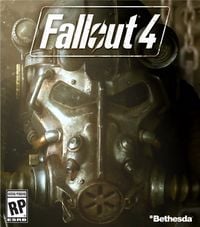
| |||||||
| Developer | Bethesda Softworks | ||||||
| Publisher | Bethesda Softworks | ||||||
| Platform(s) | Playstation 4, XBox One, Windows | ||||||
| Genres | Action role-playing game, third-person shooter | ||||||
| Rating(s) |
| ||||||
| Available From | |||||||
So it’s the beginning of the New Year, and I feel even less fresh than I did last year. Maybe it’s something in the water… oh wait, Australia doesn’t bloody have any. That could be it. As I traditionally have always done, January is sort of a “catch-up” month to get a hold of whatever end-of-year game I wasn’t able to review in the previous year to make up for the fact that I’m so casual that I need a full month to beat and review a game. Well that’s not entirely true, I take the chance to also play through a large backlog of games released throughout the year I didn’t get a chance to play in preparation for my Best Games of the Year list because my opinion is just so invariably important that you need to know what I deem worthy of public recognition every year. Anyway, I had a copy of Star Wars: Battlefront all prepped and ready to be played and reviewed, I had even allocated time and internet usage to getting professional verbal abuse time in my daily routine, but I ended up wasting all my time listening to Kendrick Lamar and crying myself to a slow but inevitable demise between extended sessions of Fallout 4 because I have no control over my life anymore, so fuck it, let’s just do a review of that instead.
Fallout 4 has been a long-awaited release from Bethesda, following New Vegas by a full five years which was widely considered to be a disappointing sequel to Fallout 3 as it didn’t copy off Fallout 3's homework so much as it stabbed it behind a dark alley, stole all of its identification, and then cut off its face and wore it like a mask. So it’d probably be more accurate to say that we haven’t had a true sequel in the franchise since 2008, but here we are now with the latest journey into the barren wastelands of what looks like Frankston North on a good day, so let’s get right into the meat of things.
So you’re a customisable berk of the gender of your choosing whose family signs up to be assigned to safety Vaults in the event of nuclear war just in time for the Soviets to bring the radiation party to them, where they’re promptly placed into cryogenic sleep to stop their bitching about how all their loved ones are gone. Anyway, you get awoken only to see your lover get shot and your child kidnapped by mercenaries, so upon your own release from the capsule, you set about to loot corpses, punch bears, and build houses for the poor… oh and maybe rescue your child if your schedule sees fit. As you can design your character to look however the hell you want them to, a great deal of fun can be had here, making them look semi-deformed or making them look like Hannibal Lector to take full advantage of the Cannibalism perk available in the game. I made my character a black lady with a pompadour, instantly equipping the first suit I could find, so I could savage the wastelands with my hardcore grooves as Janelle Monae. A woman can only dream…
The core gameplay follows the same path as previous instalments, built on an RPG-style levelling system that’s actually surprisingly layered, allowing you to put points into seven different skill categories, each with their own linearly branching collection of skills that can be upgraded depending on how many points you have in the base skill. I went primarily for skills under the Charisma banner since being able to barter my way out of situations like a modern day Benjamin Franklin makes me feel better about my own social life. Combat is the same as ever, being a shooter with a very diverse range of potential weapons at your disposal that is aided by V.A.T.S., a long-standing aiming system in the 3D Fallout games which slows time down as you pull from an endurance metre to get some free shots off on an enemy of your choosing, being able to target specific parts of their bodies to disarm, blind, or cripple them, depending on how much of a bastard you are.
Of course, V.A.T.S. isn’t the only way to fight this time around, and thank Zombie Christ for that. While I do like the snarky writing and environments of Fallout 3, the gunplay is so damn muddy that it forced you to rely on V.A.T.S. for every single enemy encounter so you don’t unload an entire clip on the wall behind your target. Now it’s actually possible to shoot people’s heads clean off without having to re-enact a Zack Snyder film, and by Poochy does it make the game feel smoother than ever before. The gunplay is supported by a crafting system that makes use of every single bit of vendor trash in the game, so grabbing broken lamp shades or toy spaceships now does more than simply make you the belle of the Hobo Ball. Power armour is still around, and damn does this game not mess around with that, throwing you into a suit of power armour in the first mission and letting you kill a Deathclaw, of all bloody things. That’s certainly one way to get the player pumped for an action-packed lizard-slaughtering adventure.
This crafting also extends to a completely new gameplay mechanic in the form of settlements, which is kind of like a post-apocalyptic Animal Crossing, which feeds into my thesis that the Fallout series is set in the future of Animal Crossing when you stop playing it. Animal Crossing is actually a very apt comparison since this aspect of the game is largely spent prettying up the settlement and tending to the whims of your extremely demanding tenets, who are all needier than a Youtube celebrity. Unfortunately, while I appreciate Bethesda’s dedication to giving the player more ways to completely waste time, the construction mechanics are fiddly as fuck; since the button used to select objects in the menu is the same button used to pick up existing objects, it led to several awkward instances where I’d be trying to build a bed but ended up lifting the entire house instead. Bloody hell, mate, if you’re that strong, then why the fuck are you using a gun?
But hey, unless you’re an obsessive compulsive fussy mother that needs to make sure she has her thumb in every plum, then you can easily just ignore the settlements and get back to shooting things and trying to bang hot reporter chicks. Speaking of which, the Companion system has been refined as well, with a greater deal of effort invested towards marrying their personalities to the gameplay mechanics; whereas in previous games, your relationship with companions was structured entirely around a linear Karma metre, the characters in this game have various likes and dislikes that can overlap with other characters, even if those characters may have ideologies that otherwise contradict each other. This makes for more interesting character dynamics, as you have to pay closer attention to their dialogue and behaviour to determine what gets them going or what’s liable to get a hot iron prod shoved up your urethra. It helps that the majority of the companions are genuinely likeable and well-written, especially Cait, the Irish lady who is the kind of person you could gleefully start a punch up in a bar with and treat it as a bonding session. Unfortunately, this nice writing is not carried over into the player's dialogue options, which are a far cry from the wonderfully verbose and often amusing choices you had in previous titles; no, here, you just got the option between Yes, No, Sarcastic, or Asshole, all of which amount to the same thing, just with varying levels of cuss words. Certainly not the kind of generic commentary I'd expect from The ArchAndroid.
All in all, I really enjoyed Fallout 4, it was great to play both in short bursts and in long-winded “I forgot to have lunch today goddammit” sessions, and the engaging characters, improved gunplay, impressive crafting system, and overall atmosphere was certainly enough to keep me glued to the game for weeks. Yea, the settlement mechanic is bland, the dialogue choices are dull, the missions can often feel a bit repetitive (especially those goddamned Settlement missions), and overall it's a bit shallower and more easily digestible than previous entries in the series, but is that really worth throwing away the chance to bitchslap a giant mutant lizard to death with your bare hands? Didn’t bloody think so.
DragonFreak's Review Quest
Written by: DragonFreak (talk)
| 200% Mixed Juice | |
|---|---|

| |
| Developer | Orange_Juice |
| Publisher | Fruitbat Factory |
| Platform(s) | Windows |
| Genres | Turn-based role-playing game |
| Rating(s) | N/A |
| Available From | |
100% Orange Juice is a popular game in this community. Many people, including me, love its playable cute anime-looking girls, the fast and fun gameplay, and the crazy battling action. I do not like party games all that much but I am a fan of 100% Orange Juice. Now the same creators of 100% Orange Juice has released a new game which is an RPG version of the 100% Orange Juice universe, obviously called 200% Mixed Juice. When I first heard of this, I was very excited for it, and I bought it almost immediately after it was released.
In this game you play as Protagonist, who is a nameless, faceless character literally named Protagonist. You are accompanied by a fairy named Navi (who is slightly less annoying than the Navi in Ocarina of Time). Almost immediately, you are thrown into this battle school and meet up with one of the main characters of the game: QP, a cute dog-tailed girl. Soon after you join up, mysterious forces start to take place. You are transported into another universe. And then another. And another. You join up with two other main characters: Marc and Sora, and learn that all the universes are mixing. They have to stop this mixing or all the universes will be destroyed.
In each world there are a series of levels that have a battle. As you progress, you can buy cards of characters and use them in battle. Each character is one of three types: Rock, Paper, or Scissors, which of course have the same advantage over each other as in a real game of Rock, Paper, Scissors. The battling system is functioned a lot like Pokémon. You choose a party member to battle against your opponent and it is a 1-on-1 fight until one entire team is wiped out.
This game does a couple of things right. First and foremost, I believe the game’s goal is pretty much to be a fan service to the 100% Orange Juice community in the style of an RPG. It definitely does that, and does it pretty well. It is really neat to see how characters, enemies, and items are incorporated into this RPG. The overall plot of the game is alright. It is not complex in the slightest, but there are one or two parts that may make you say “Wow I did not expect that”. Also the music is amazing, just like 100% Orange Juice. I would not say that it is better, but it is still very good. Too bad that it is hard to fully enjoy it as the looping is terrible. After an end of a song, there is a three second pause and starts up again. Other than that, it is solid soundtrack.
This game does have flaws, and they are pretty bad. First of all, the game’s mechanics are just way too simple. The three types are rock, paper, and scissors, which to me seems lazy that they could not come up with better typing. Of course maybe this was fully intended. Either way it does not add much depth to the battle system. There is also a couple of major difficulty spikes where to boss of some worlds are so much more difficult than regular enemies, forcing you to grind 5-10 levels. Maybe even more for the final boss. Luckily it does not take terribly too long to level up which makes this many difficulty spikes somewhat tolerable. Lastly, I feel like the only characters that are truly good at battling are the three main heroes: QP, Marc, and Sora. Now I would have to do another run, but when I used QP, the other two characters I used, even though they had the same levels as her, could simply not keep up in strength and health as QP. Same thing happened when I switched QP out with Marc. I compared this with 6 non-main hero characters I used and none of them could keep up with QP and Marc. Which when there are possibly dozens of other characters to use which none or not many of them can compare to the three characters you are going to get by default, it ruins the experience of trying to strategy a team you would like and have it be good.
200% Mixed Juice does 100% Orange Juice right, but not necessarily the RPG elements. I do recommend playing it if you are a 100% Orange Juice, because overall it is pretty fun. Now I said I recommend playing it definitely, however it may be a little too overpriced the most basic of RPGs. Maybe it is because I am cheap, but even though I did pay full price for the game, I do feel like it was lacking in content that would make up for that price. Nevertheless, it is still a fun game.
Character Review
Biddybud
Last month I focused on a 3D game, when I'm back to doing that again, and this time with a review of what may actually be one of my favourite enemies ever: the Biddybuds.
In all honesty, I don't know why I like the Biddybuds, I just do. But it was refreshing in Super Mario 3D Land to see a common enemy that wasn't a Goomba. I'll admit to not having played the game for a while, but I remember Biddybuds and their flying variant appearing in quite a lot of levels, it gives hope that the Mario series isn't just going to fall back on its established enemies, it's going to give others a shot as well. And whilst admittedly that shot makes them weaker than a Goomba, seeing as they don't pursue Mario in any way, it's a nice change in scenery. They appear in further games, just never again in the same capacity as they did in 3D Land, which is quite a shame, because I feel there are varying types you could encounter: Biddybuds with shells, or undead ones for example.
It's also impossible to deny that Biddybuds are perhaps the cutest insect enemy to ever grace the Mario series, although that's not saying much. But their cute look is something else that endears me to them, they look like they don't even know what they're meant to be doing, which kind of makes it hard when you're mercilessly slaughtering them.
However, I have a gripe with them, and that it that they're all the same. Biddybuds come in five different colours: red, green, yellow, blue and pink. And those colours are only there so they're different colours. Their behaviour is exactly the same no matter what colour you encounter, and you'll only encounter different colours if there is a group of them, otherwise you're stuck with the bog standard red one. If Koopa Troopas can act differently due to their shell colours in 1985, I don't see why Biddybuds can't in 2011. It seems like lazy enemy design, which is a shame because otherwise my opinion on them would be even higher.
So yes, you can find more variety in a bag of Hula Hoops, but these little insects at least managed to make Goombas look threatening, and showed us hope that different enemies might become staples in the Mario series, even if now they've gotten the shaft again.
Location, Location
Written by: Time Turner (talk)
| Future Dream | |
|---|---|
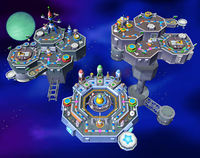
| |
| Music | "Space Match" |
| Area | Dream Depot |
| Inhabitants | ...Capsule Dispenser? |
| Enemies | Bowser, Koopa Kid, Capitalism |
| Items | Stars galore |
| First Appearance | Mario Party 5 (2003) |
Hello, ravenous readers of The 'Shroom! My name is Time Turner, and for the fifth near-consecutive time, I'm more than glad to welcome you to another instalment of Location, Location! In the last issue, I spent fahr too much time tearing into Fahr Outpost, and around Christmas time, no less. I still feel kind of bad about my Scrooge/Grinch impression, though I still fully intend to bring in my brand of dissection. This time, I wanted to cover something that I have fond memories for, something that stayed with me in my dreams, something that could take me to the farthest reaches of outer space, something that most of you probably don't know or even recognize. That's right, it's Future Dream!
Let me give some personal context for Mario Party 5: I have the fondest and yet vaguest memories from playing this game. When I grew up, I owned the four Mario Party games released for the Nintendo GameCube, which includes Mario Party 4, 5, 6, and 7. My friends and I tended to gravitate to every game but the fifth one, and in my spare time I always preferred the seventh one for all of its bells and whistles. Still, I did enjoy my time with Mario Party 5; whenever I looked back on the game, I felt a vague sense of happiness, but I wouldn't be able to pinpoint exactly what about the game made me happy. It’s that happiness that made me want to look back on it and see if past me knew what he was doing. With that in mind, why did I gravitate towards the Future Dream for this? Simple: its music.
Future Dream is a board that follows in the footsteps of 2's Space Land to an extent. It has all the amenities that you'd expect, which will be discussed in great detail later, but something that you'd probably not expect and something that easily lets it stand out is its music. When composing for a space-like area, you’ll either end up with a piece that’s slow and mellow (see: Paper Mario: The Thousand-Year Door) or one that’s bombastic and adventurous (see: Super Paper Mario). The orchestral piece that is "Space Match" dips far more into the latter, opening with something far more grandiose than it deserves to be before swooning into a charming but adventurous melody. Those first few seconds alone can hook you in. The premise of Mario Party 5 is that the parties take place inside dedicated areas for dreams, and this track does an amazing job of making you truly believe that you're entering a world of dreams. Think about dreams for a second, and the limitless possibilities they can offer. Obviously, the game isn't able to deliver on a limitless journey, but it does what it can to sell you on one of those possibilities.
While music is easily what can draw you in first, it can lose its grip completely if the visuals fail to deliver, and Future Dream delivers on its namesake. However, it's a bit misguided. It draws a lot of inspiration from the future of the space race more than anything else, especially with its outer space setting and rockets in every corner. There are bits and pieces reminiscent of a sci-fi B movie, such as a giant robot with a glowing light on its head and gears around it, but if you showed a full map of the board and asked someone to name its theme, almost everyone would conclude that it's based on space. Also, while the visuals that it does get across are still impressive to look at and indicative of what it wants to get across, it feels more like a small snippet of what it could potentially be. It'd take something with the scope of Super Mario Galaxy to truly nail this kind of aesthetic, and I'm not expecting that from a single board of a Mario Party game; I'm just wistfully thinking about what could have been. Overall, it gets the job done, even if it doesn't excel.
As with every Mario Party board, every board tries to distinguish itself with a gimmick, and Future Dream is no exception. The board is comprised of three different circles of spaces, and they're actually smaller than what you may be thinking of. Two of the circles have a short detour that can be taken to a secondary path, but it quickly loops back to the same point. This creates a lot of situations in which Stars can appear directly in front of a player after they've just purchased one, or a player can continuously land on the same Capsule over and over. The circles are long enough to prevent large-scale grinding while also promoting it to enough of an extent that it's not unreasonable to collect a batch of Stars in a single roll. This creates an interesting dynamic where everyone can rack up crazy numbers in a crazy amount of time, and thus, everyone has to plan accordingly. Instead of the large maps where players have many avenues to choose, they're placed into a constrained space where their options are limited, and this single difference can create a lot of strategy and a lot of fun.
Each of these circles is completely separate from one another; it's impossible to get from one to the other on foot. Since leaving the players stranded on a single peninsula would be boring, there are a variety of transportation modes at your disposal, including teleportation pads, giant rocket ships, rotating pods that are more liable to make you throw up in zero gravity than anything, and the "air taxi", which is a much cooler name for the slow-moving triangular wedge than it actually deserves. The teleportation pads can be triggered by moving next to them, but the others require you to land on a specific Event Space. Beyond the folly of elements outside of the board, such as Warp Pipe Capsules or Klepto Capsules, this is how you're getting around. Having these limited options forces the players to think of the optimal route and whether or not they want to chance their dire roll on it. It's important to remember that the series has always been as much about strategy as it's been by luck, newer instalments notwithstanding, and making players work in an uncomfortable situation only promotes more of that strategizing.
There are other goodies to be found on the board, with plenty of attractions that would be more at home in Tomorrowland (the theme park, not the Bird movie) than a party game. This includes the Merry-Go-Shuttle, which lets you ride in a miniature rocket while attempting to collect coins, and the capsule slots, which let you play a slot machine on the front of a high-tech robot with the chance of getting a cool Capsule if you're lucky and a Mushroom Capsule if you're not. True to form for the board, these are the only attractions after the modes of transportation, and I'd be lying if I said I wasn't a bit disappointed. Though the smaller size does promote a balance of gambling and planning, having a lack of variety really compounds that fact a bit too much. They're still fun diversions and give players that extra boost they need to launch into first place, but with the promise of a world fuelled by dreams of the future, your expectations are going to be set too high.
Mario Party has always had its charming characters to support the players on their quest to become the richest. Something as minute as 5's own Thwomp and Whomp at Pirate Dream can help in making a location feel alive, but when characters are developed above and beyond the usual, such as Captain Goomba from Mario Party 8 or the Koopa Master from Mario Party 7, it gives an opportunity to personalize each and every board. Future Dream, unfortunately, has neither of those. There are technically plenty of characters that show up, but they're all of the Capsule variety, meaning that they're not unique to the board. Besides them, you have the Capsule Dispenser and the Star Spirits that host the boards' activities, on loan from Paper Mario and again non-exclusive to the board. While that's not to say that they don't have personality, they can appear in any of the boards, meaning that they do less to support the boards they appear in and more to distract from what's already there. This is bad when one of the biggest draws to Mario Party is the boards.
It wouldn't be a Mario Party game without a tacked-on story mode, though Mario Party 5 ops to put a little more effort. Instead of playing a regular party game with Bowser casually looming in the background doing whatever evil overlords do when they're taking over the world, you're playing a party game on an abridged version of each board against Bowser's underlings, the Koopa Kids, with the goal of stealing their coins. In the long run, it's not much of a difference, but it feels like an actual attempt to give a single-player experience to an ostensibly multiplayer game. In Future Dream's case, the three small circles are crammed into one slightly larger circle. The rockets and teleportation pads only move people to the other side of the board, and the air taxi and other attractions have been completely removed. While I admire it for putting a new spin on an existing board, it condenses a board that already felt condensed in the first place, which is not to its advantage.
As it turns out, I'm not very good at not being negative, but I'd like to think that I gave it an earnest attempt. There are great elements in Future Dream, such as its condensed space, music, and overall aesthetic, which are overshadowed somewhat by the lack of characters to interact with and a general lack of interesting diversions. Am I asking too much from a Mario Party game? Maybe, but if I ever have choose which game I want to play with friends, I'll be thinking about what stood out to me the most. Even if it's for a single board, if all I remember about a board is its appearance and not its actual gameplay, I'll be less inclined to pick it up. Regardless of how minor you may perceive something to be, it's important to critique every aspect of it with the hopes of turning out a better product. Everything can be improved, bit by bit, and I'd much rather have something great than something okay. Otherwise, we end up with Mario Party 10.
Book Reviews
| The Three Musketeers | |
|---|---|
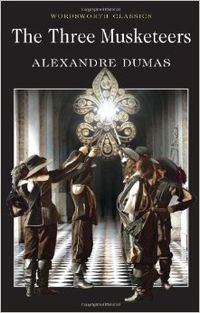
| |
| Author | Alexandre Dumas |
| Release date | 1844 |
| Genre | Fiction |
| Pages | 592 (depends on edition) |
| Available From | |
Hello, all, and welcome to a special Classical Literature edition of Book Reviews! This month, I will be reviewing a book I do enjoy reading, The Three Musketeers! Please enjoy a spoiler-free review!
If you know me, or if you’ve seen me poking around on the forums, you know exactly why I enjoy this book. But, for those of you who don’t know me, I shall clue you in. My favorite trio of Legendary Pokémon, the Swords of Justice, (or the Muskedeers, as I prefer to call them), are based on the quartet of sword-slinging heroes from this book. Keldeo is D’Artagnan; Cobalion is Athos; so on and so on, etc., etc. While I was waiting for the 15th Pokémon movie to come out (it’s fantastic by the way, you should really watch it) in the summer of my senior year of high school, I decided to pick this up to actually be able to know what the book is all about. I was ‘eh’ about it then, but I recently read it again last spring in college, and it piqued my interest quite a bit more. I actually had the desire to go out and buy it, so the copy I have is not the one I have up there, but it’s a really old used book that’s almost falling apart. Also good to note is that you can get this book free on Google Play, so if you, say, have an old edition that’s falling apart and you want to keep reading the book while you’re in math class, that’s definitely the way to go. At least for me.
Anyway, enough of my rambling, let’s get to the actual review. The Three Musketeers is written in that really old style of breaking up chapters into anywhere from 4-16 pages, so the book is 67 chapters long. This makes it easy for you to pick up the book, read a few chapters, and be able to put it down without being trapped in a chapter without a break for 45 more pages. Main characters here are exactly who you’d expect: Athos is brooding, gruff, and constantly drunk; Porthos is big, strong, and incredibly vain; and Aramis is mostly upbeat, eloquent, and good with women. D’Artagnan is a bit of a twit, honestly; at least in the beginning, but he gets better. The only characters I really don’t like in this book are Milady and Felton. Fucking Felton. Go die in a hole, bro.
Basic plot time! D’Artagnan is a young pup, leaving his family home to set out to become a Musketeer. Along the way, he gets into a fight with a man at an inn and gets his ass whupped but good. While he’s unconscious, the man steals his letter to Tréville, captain of the Musketeer corp. Thus begins D’Artagnan’s quest to right the wrongs done to him and get his letter back. Along the way, he gets tangled up in the throes of war and a passionate affair between some very high-ranking members of royalty.
If you want me to be perfectly honest, I wouldn’t recommend this book to anyone that’s not 100% invested in reading it. It gets really slow in places, especially in places where the Musketeers aren’t currently in the scene. There’s a big part near the end of the book where they’re absent for like, ten or eleven chapters, and that part just drags on. And you have to read about fucking Felton too. Ugh. This isn’t the only part that’s like this. It slows way down whenever they start to talk about politics, too. It doesn’t flow like the way J.R.R. Tolkien writes, with periods of action gradually followed by periods of rest. This book is basically a swordfight, followed by dialogue, followed by a long resting sequence, followed by more dialogue as the Musketeers figure out what to do next.
One unique thing Dumas does, though, is pulling a 3rd person omniscient narrator. The narrator will follow every character along, not just D’Artagnan. You get to see what Athos, Porthos, Aramis, Tréville, even the King, are doing during the book, and it’s unique. You, the reader, know more about most of the characters and what they are doing than the characters themselves at most point, save for one instance at the end of the book that is incredibly satisfying. You’ll find yourself rooting for his heroes and despising his villains, as they are all very well-written. Even fucking Felton. Ugh.
Again, I wouldn’t recommend this book to anyone who is only looking for a casual read while they wait for something better to do. If you’re looking for a new classic to add to your reading list, however, pick this book up and give it a try. If you can get it for free on Google Play, it’s a good read, despite a few mistakes in the translating and updating. Like I said, when I got to reading this last spring, I had a hard time putting it down. It’s a good read, despite the slow parts.
Except for Felton, of course. Fuck you, Felton.
Graphic Novel Reviews
| Bandette, Volume One: Presto | |
|---|---|
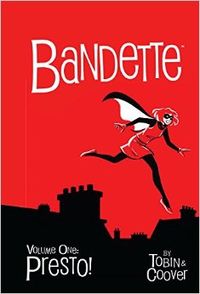
| |
| Author | Paul Tobin |
| Release date | 2013 |
| Genre | Graphic Novel |
| Pages | 136 |
| Available From | |
Greetings, my fair readers, welcome to another edition of Graphic Novel Reviews! This month I’m reviewing one of my favorite graphic novels, the amazing adventures of Bandette! There will be spoilers for Vol. 1 in here, so be careful!
Bandette and I have a fond relationship. I picked up the first book at a Vault of Midnight while on a trip to another city with my parents. The book, which is hardcover, is a gorgeous one. The pages are good-quality paper and the colors are all vibrant. The first few pages were enough to draw me in, and I bought it in a fury of fifty dollars’ worth of comics. But it’s a purchase I don’t ever regret.
You must understand, Bandette has a wonderful vibe. She is free, she is stylish, and she is a thief. I’ve seen her best described at the bookstore where I recently picked up the second book (which I’ll review in the future!) , that she is ‘a Robin Hood for the modern age,’ and I couldn’t agree more. Bandette steals from the rich and corrupted, and gives back to the poor, and her friend, the art insurance agent; returning priceless pieces, but keeping a trinket or two for her secret stash. She has a group of ragtags she refers to as her ‘urchins’ and they are absolutely charming parts of her story, helping her with whatever she needs. Presto!
Onto the plot, which is a fun one indeed. Our story begins in Paris, where Bandette has pulled off a daring heist of four miniature drawings by Rembrandt, from a shady arms dealer who has a history with FINIS, or Friends In Need Improvement Society. FINIS, as you may guess, is your standard shady operation, much like Lysandre Labs or Team Rocket. They parade around as a charity, helping the impoverished, but most often they run on the bad side of the law, containing some of the most corrupted billionaires and politicians in the country. Some of them are international arms dealers, but they drabble in drugs, sex, and murder as well. Basically: bad people who need to go. Luckily, Paris has two thieves to rely on!
Yes, you heard me right. Bandette has stiff competition from the other prominent thief in the city, the mysterious Monsieur! A used bookstore owner by day, the dashing Monsieur by night, he is Bandette’s greatest rival, for both the treasures that they steal and the title of Paris’ greatest thief. Think of a gentleman Catwoman here and you won’t be far off. A gentleman Catwoman-meets-Batman, if you would.
Back to our plot. Monsieur, on a heist, overhears the leader of FINIS, Absinthe, plotting to his men to kill Bandette, as she has been a thorn in their side for too long. Concerned about his rival, as she is only a teenager, Monsieur arranges a meeting between the two of them, and Bandette agrees. However, while they are meeting, Bandette is pulled away by her other rival, Matadori, and Monsieur is drawn away by Absinthe’s mistress, who wants to get back at him for all the crimes he’s committed. She reveals a list of priceless treasures that “Absinthe would surely miss” if stolen, and he agrees to help her out. But, before he can look at the list, Bandette snatches it right out of his pocket.
Once they meet again, Monsieur manages to get it back, and she also proposes a competition between the two of them. Whoever manages to steal the most items on the list wins the title of ‘Paris’ Greatest Thief.’ They also agree to turn over any evidence incriminating Absinthe and FINIS of their nefarious deeds to Inspector B.D. Belgique, Bandette’s bedraggled, Craymore-smoking police correspondent. With the formal agreement out of the way, the two get to thieving.
Elsewhere, an unhappy Absinthe chides Matadori for failing to kill Bandette for him. She’s ordered to death, and she is dragged away by two henchmen and the only thing left of her and her charming cape is the loud BANG. Absinthe then calls in more help to destroy Bandette, and his sneaky mistress watches on in horror as a man with a 1 and a 3 tattooed onto his hands enters the room…
And the rest is To Be Continued in Bandette, Vol. 2: Stealers Keepers! What you now have is a collection of mini-comics and a longer story to read! The mini-comics are all drawn by guest artists, and they’re funny to read and a quick burst of fun before you put the book down. My favorite is “The Mystery of Monsieur,” and if you’ve been paying attention throughout the story, you should be able to spot all the cameo characters that come in and out of it. Also contained in this bonus section is a guide to everything Bandette has stolen in the issue. Yes, these are real items, and Tobin and Coover have gone to the trouble of making a guide for you to read in case you want to know more about each item. We then move on to a screenshot of the story board of ‘Bandette,’ then we finally end up on the obligatory ‘description of the process used to make Bandette.’ Presto!
Bandette is a charming read full of fantastic characters. Bandette herself is clever, quirky, and so stylish, and should be a staple in your ‘Comic Book Heroines’ album. Heck, she’d fit into your regular Heroines album! So don’t delay, go read Bandette today! You won’t regret it! Now, I must be off, but be sure to check out my other review for this month in Book Reviews! See you next month, everyone!
The Stoob Tube
Written by: Stooben Rooben (talk)
Hay everyone, and welcome to Critic Corner's second edition of The Stoob Tube! I am your darling writer, Stooben Rooben, and I am here to help you find television entertainment that won't liquefy your brain! Well, actually, TV's not all that bad, but it still helps to know where to look — and that's why I'm here, to introduce you to good entertainment. Or, in the worst case, tell you which programs to avoid.
I will try to hide any significant spoilers in black bars that you have to highlight to read.
| BoJack Horseman | |
|---|---|
| Creator(s) | Raphael Bob-Waksberg |
| Executive Producer(s) | Will Arnett, Raphael Bob-Waksberg, Noel Bright, Steven A. Cohen, Aaron Paul |
| Starring | Will Arnett, Amy Sedaris, Alison Brie, Paul F. Tompkins, Aaron Paul |
| Number of Seasons | 2 |
| Number of Episodes | 24 |
| Genre(s) | Animated sitcom, Dramedy, Black Comedy |
| Channel | Netflix |
| Running Time | 25 minutes |
| Original Run | 22 Aug, 2014 — present |
This month, I will be discussing the colt classic, BoJack Horseman. Unlike my last review, which covered a program that has been on the air for so long that it's stumbling over itself and staying alive only through its eerily familial cast dynamics, BoJack is a fairly new entry into the television industry that is making considerable efforts to establish itself as one-of-a-kind. And when I say "adult", I mean "grown-up" — get your mind out of the trough. Now, how does this particular show stack up against others in its genre that are more recognizable? I suppose that depends on what you're looking for, and how long you're willing to spend looking for it.
The show focuses on its titular character, BoJack Horseman (Will Arnett), a rather washed-up star of a 1990s family sitcom, called Horsin' Around. BoJack is saddled with depression and leads a highly self-destructive lifestyle, often drowning his echoing regrets in more alcohol than you can purchase in a single liquor store. Despite his lack of recent success, BoJack has what many would consider a comfortable life — he owns a beautiful home in Hollywood, has more time than he knows what to do with, and has people around him that pay him attention and express concern for his well-being. Among these individuals are Todd Chavez (Aaron Paul), a high-spirited, yet fragile and lazy twenty-something that crashed at BoJack's house during a party "five years ago" and never left; Princess Carolyn (Amy Sedaris), a succinctly dedicated talent agent who represents BoJack and is his ex-girlfriend; and Mr. Peanutbutter (Paul F. Tompkins), an optimistic and selectively-oblivious TV personality who served as BoJack's network rival in the 1990s.
In the first episode of the series, we see BoJack wanting to write a memoir of his life, to be published as a book. However, after struggling to do it himself, his agent, Princess Carolyn, recommends that he hire a ghostwriter to tackle the job. BoJack decides to commission the help of Diane Nguyen (Alison Brie), who has written a book chronicling the life of his childhood hero, Secretariat. Having never met Diane before, BoJack decides to host a party to break the ice, at Todd's suggestion. In the final moments of the pilot, BoJack and Diane meet, and the interaction they have is surprisingly real. At this point in the show, though, these kinds of moments aren't all too common.
In fact, for the first few episodes, the series doesn't seem to establish much in the way of promise. Rather than focusing on any sort of attractive story line, the producers, writers, and animators instead spend a great deal of time establishing the world in which BoJack lives. While there are visual gags aplenty and a sense of continuity being formed, there are some clips that newcomers to the series may find awkward because of a distinct twist in the show's universe: human-sized, anthropomorphic animals and bugs exist and function alongside humans in every possible way each day. This intermingling weasels its way into these creatures' work, socialization, romance and sexuality. Assuming you have no problems with this concept (the way it's portrayed in the series really is not creepy, barring a few thought-provoking exceptions), the only thing that may bother you for the first stretch of the show is its penchant to force just how funny and adult it is in your face. Drug references and purposely-offensive humor (including a couple of ham-fisted Holocaust and 9/11 jokes) dominate much of the early episodes' scripts, while most of the remaining content can be divided up into "moldy cracks" and "meta madness". Admittedly, there does come a point where the show matures by leaps and bounds, but the series' first four or five episodes are basically polluted with tryhard jokes, which is a shame since the plots for these episodes aren't half-bad. The only bits I would say fit in well with the series as a whole, are the many aesthetic jokes that are implemented to build up the BoJack universe. Actually, if anything, these little references pave the way for some truly outstanding jokes a little farther down the line — and, maybe, that was the point.
You may think, four or five episodes wouldn't be so bad, and if that's the case, I don't think you'll have a problem hanging on long enough to experience the truly entertaining parts of BoJack Horseman. However, I do think in a show where the seasons are only 12-episodes long, that the value and importance of each episode increases; if around 35% of the season is a dud, the math starts looking unfavorable. Luckily, the other 65% of the season is of much higher quality, and makes up for the disappointing foundation for the series.
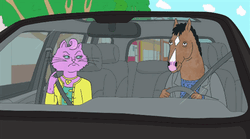
I think the first episode that really grabbed my attention was the fifth of the first season, "Live Fast, Diane Nguyen", which introduces us to Diane's family and how horrible they are. Not only does the humor in this episode improve in quality, but it also dives head-first into a relatable pool of family drama. The episode ends with BoJack going out of his way to lift Diane's spirit, more than we've seen him do for any other character (even himself) up to this point. He then gives Diane a speech about how "family is a sinkhole", and reassures her that escaping her family and moving forward through the dense fog of life was the only option. The way this speech is executed serves as a sort of turning point in the series, giving viewers a glimpse at just how deep this show eventually intends to get. From here, the show only gets better.
The remainder of season one connects more fluidly than its first part. While there are still a number of goofy sub-plots and distractions going on, the completion of BoJack's memoir becomes a more important fixture in each episode. Due in part to the urgency behind completing his memoir, through this stretch of the series, we get to see more visibly how BoJack's depression has impaired his life in the past and continues to affect him to this day. I don't want to spoil too much of the show's method of progression, but it's really an interesting shift in tone that, in more ways than the humor, kept me coming back to the show. I wanted to see what was going to happen to BoJack. I wanted to see how his life and his choices would affect his friends. I wanted to see BoJack make changes to improve his happiness. The show's pull in this manner is unlike any other I've seen, at least in western animation. By the end of the first season finale, I felt like the show had done a complete one-eighty in quality. It was a smooth and rewarding transition that made me very grateful I hung on through its rocky launch.
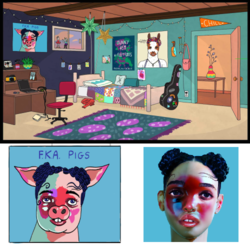
Season two picks up where season one left off, both in its plot and in its strength. BoJack is given a new chance at success in his life and tries to adopt a better attitude and outlook on life. Although, as we all know, efforts like that are much easier said than done. More of BoJack's past is explored in this season, much of it making clear why BoJack is suffocating from his own depression. Despite this understanding, though, it can still be difficult to feel sympathy for him when he makes very petty or morally questionable decisions. The trend continues in each episode, but it's not in a way that seems to recycle its own format. Each episode feels like a large, believable addition to the show's universe. It makes the show incredibly immersive.
Another thing that helps the second season is its exploration of sub-characters. Todd, Mr. Peanutbutter, and Princess Carolyn all have much larger roles in this season, many of which are equally as interesting as BoJack's own. Diane, seems to be featured slightly less in season 2 , but her impact on the characters around her is still very noticeable. Minor characters who were mentioned or shown only a few times in the first season, are given much more substantial roles in season two. The season also doesn't skimp out when it comes to introducing new, interesting characters, either. None of these character introductions or expansions end up confusion, which just makes the presence of every single one of them even more rewarding.
The actors who portray these minor characters are often quite famous names or recognizable voices, including the talents of Lisa Kudrow, Stanley Tucci, Wendie Malick, Olivia Wilde, Alan Arkin, and the yellow M&M. Wendie Malick is my particular favorite among the guest actors; she voices BoJack's mother, Beatrice, and she's truly nasty — believably nasty, too. It's kind of frightening. If those names aren't enough "famous" for you, though, the show has also been known to pull in some celebrities to play exaggerated versions of themselves. Henry Winkler, Naomi Watts, Paul McCartney, and Character Actress Margo Martindale are just some of names and faces you'll probably recognize.
Right, so, I've babbled about the show's expansive universe, characters, jokes, pacing, and talent pool, but do all those things together make it a unique show? ...No. If I were to consider only those details, the only thing that would make this show unique is its Hollywood-inspired setting. There is much more to this series than those traits, though. Regardless of its vast charm, there is one aspect BoJack Horseman truly excels in, above any other American program that's a part of this television generation: it's portrayal of depression.
The series is very much a comedy. There are tons of goofy things going on in every episode. However, the situations many of the characters find themselves in are often the result of depression. While we all know going in that BoJack himself has numerous problems due to his severe depression, it's steadily revealed over the course of the show that pretty much all of the main characters are suffering from some form of depression, anxiety, or esteem issues. Each one copes with their problems in their own way, but still run into difficulties moving forward. For example, while BoJack routinely relies on addictive substances to forget his problems, Princess Carolyn distracts herself with her work and her clients, rarely spending any time by herself unoccupied. Even Mr. Peanutbutter, the happiest bloke in the cast, has security issues and will lift his overly-cheerful veil in some strangely impactful scenes; yet, the way these scenes are done aren't totally atypical of the way a dog would switch between happy-go-lucky and deeply saddened during an upsetting day.

If you're wondering if all this attention on depression in the show will make the show unfunny, that's certainly not the case. The show doesn't poke fun at people who suffer from depression; rather, it provides insight as to why depression affects certain people the way it does. This can make the show feel pretty heavy at times, but it somehow always knows exactly when to place a joke to alleviate the mood, many of which are realistic remarks I could fathom hearing (or have heard) in every day life. Perhaps even more accurate, is that the show never shoves the word "depression" in your face. The characters never openly admit that they're depressed; signs of misery may be obvious to the characters, but none of them will confess how they truly feel. There is only one instance in the series I can recall where the word "depressed" was used, and that was during a drug-induced hallucination where BoJack was speaking to his subconscious — literally, just him being honest with himself.
If you suffer from depression yourself, seeing the characters go through the motions hits home that much harder. Occasionally, you'll see a character have zero motivation to get out of bed. Other times, they may feel like a freak because of how much their depression, anxiety, or fears have gotten in the way of their life. Todd, for instance, will fall back into video games relentlessly when he is overwhelmed; yet, he feels it's a harmful habit when it comes to his creativity, and doesn't want to be stuck where he is for the rest of his life because of how easily he lets himself get distracted. That struck a chord with me.
The show has a Breaking Bad essence about it (undoubtedly because of Aaron Paul's ties to the show), which makes the whole trip feel like a sort of downward spiral. You know things can't get too bad, because it's a very funny cartoon, but there's a looming ambiance of finality that the show evokes in its darkest moments — it really makes you feel like, at some point, BoJack could very well kill himself. BoJack does bear some similarities to Walter White of Breaking Bad, in his demeanor and actions, too. He's a middle-aged man who is desperate for a change; he verbally abuses Todd (like Walter did to Jesse), yet coerces that same person to help him in all his shenanigans; and he's highly destructive to himself and those around him, often thinking about himself before anyone else.
Despite any similarities BoJack has with other series, it retains its freshness in every episode. This can frequently be due to rearranging the cast dynamics; in some episodes, rather than BoJack and Todd working together, you may see Todd and Princess Carolyn, or Todd and Mr. Peanutbutter, or Mr. Peanutbutter and Diane. I believe each of the main five characters have been paired with each other in different episodes (which is pretty impressive, considering there are only 24). Adding flavor to these combinations, are the plethora of guest stars I mentioned earlier. This makes the series feel very roomy in its presentation, since it makes way for recurring themes and new material. In other words, when you watch this show, you won't feel confined to liking only one or two characters. Odds are, you will find several that keep you coming back, even if they are only minor characters like Vincent Adultman or Wanda the Owl.
To compare BoJack Horseman in its entirety to another show would be pretty difficult. It has the character development of Breaking Bad, the spontaneous humor of Scrubs, the Saturday-morning feeling of Ed, Edd n Eddy, the enormous multi-specie world of Futurama, and the tactful observation of Peanuts. Toss all of those into a blender with some absinthe and Zoloft, and I guess you'd get something that looks and tastes like this show.
So, do I recommend this show? If you've read this far and don't know the answer, you're probably not paying enough attention. BoJack Horseman is an outstanding adult animated series. It blends classic humor and animation with an unusually intelligent outlook on the life of an individual inflicted with depression. If you don't have depression, some of the relation in the show may not click with you, but the show will certainly provide some understanding with how depression and anxiety affects everyone differently. The humor in the show, its pop culture references, and constant Hollywood lampoons add quite a bit of density to BoJack, which should make it at least mildly enjoyable to anyone willing to stick out the first half of season one. If you suffer from depression or personally know someone who does, the show becomes a lot more complex and weighted, but equally more enjoyable. It's quite an achievement in western animation, I'd say. It's definitely worth checking out if you haven't. Or, if you did check it out, and didn't hang around past the first few episodes, I'd recommend giving it one more try and sticking around through season one. If it doesn't grab you, then it's just not your thing. If it does grab you, though, it's the kind of show you're going to appreciate more and more with each re-watch.
Although, if you think I have bad taste, you could always look to the person who hired me to do this job:
Crocodile Dippy: Bojack Horseman has a lot of sources you can compare it to, yet nothing quite like it exists. Its rapid-fire humour interspliced with some truly engaging character drama make it almost comparable to Scrubs, while its half-wonky animation style and adult humour can be likened to a show Archer. However, I also once saw someone half-jokingly compare Bojack's severe dark overtones to the twisted direction the original Neon Genesis Evangelion series took, and bloody hell are they not kidding.
It is so rare to find animated series that can so perfectly delve into and explore deep, complex themes with tact and finesse while still being funny. The writers certainly improved a lot as the series went on, knowing exactly when the right time was to hit you with a joke or a punch to your heart. What's more, I have yet to see a more accurate depiction of depression and anxiety in any TV show I've watched to date, speaking as someone who has struggled with these horrible conditions. It's remarkable that the writers took the time to research the many emotional, social, and mental issues that Bojack and, indeed, many characters display throughout the series.
Yes, the first few episodes leave a lot to be desired, and the crude art style and bizarre setting may be off-putting at first. But dammit, Bojack Horseman is so much more than just a crude animated comedy, and it deserves the same respect from TV goers that the writers clearly give to their audience.
With all of these words having been said, I suppose there is only one way I can summarize this review...
| The 'Shroom 106 | |
|---|---|
| Staff sections | Opening Statement |
| The 'Shroom Spotlight • Directorial Address | |
| Sub-teams | Fake News • Fun Stuff • Palette Swap • Pipe Plaza • Critic Corner• Strategy Wing |
| Specials | Ultimate Character Tournament |
| Closing Statement | |
